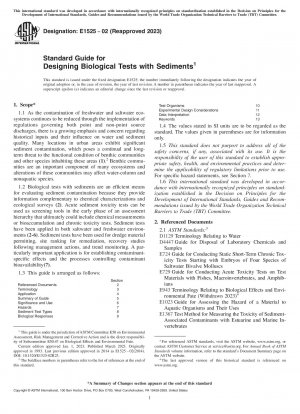ASTM E1525-02(2023)
Standard Guide for Designing Biological Tests with Sediments
- Standard No.
- ASTM E1525-02(2023)
- Release Date
- 2023
- Published By
- American Society for Testing and Materials (ASTM)
- Latest
- ASTM E1525-02(2023)
- Scope
- 1.1 As the contamination of freshwater and saltwater ecosystems continues to be reduced through the implementation of regulations governing both point and non-point source discharges, there is a growing emphasis and concern regarding historical inputs and their influence on water and sediment quality. Many locations in urban areas exhibit significant sediment contamination, which poses a continual and longterm threat to the functional condition of benthic communities and other species inhabiting these areas (1).2 Benthic communities are an important component of many ecosystems and alterations of these communities may affect water-column and nonaquatic species. 1.2 Biological tests with sediments are an efficient means for evaluating sediment contamination because they provide information complementary to chemical characterizations and ecological surveys (2). Acute sediment toxicity tests can be used as screening tools in the early phase of an assessment hierarchy that ultimately could include chemical measurements or bioaccumulation and chronic toxicity tests. Sediment tests have been applied in both saltwater and freshwater environments (2-6). Sediment tests have been used for dredge material permitting, site ranking for remediation, recovery studies following management actions, and trend monitoring. A particularly important application is for establishing contaminantspecific effects and the processes controlling contaminant bioavailability(7). 1.3 This guide is arranged as follows: Section Referenced Documents 2 Terminology 3 Application 4 Summary of Guide 5 Significance and Use 6 Hazards 7 Sediment Test Types 8 Biological Responses 9 Test Organisms 10 Experimental Design Considerations 11 Data Interpretation 12 Keywords 13 1.4 The values stated in SI units are to be regarded as the standard. The values given in parentheses are for information only. 1.5 This standard does not purport to address all of the safety concerns, if any, associated with its use. It is the responsibility of the user of this standard to establish appropriate safety, health, and environmental practices and determine the applicability of regulatory limitations prior to use. For specific hazard statements, see Section 7. 1.6 This international standard was developed in accordance with internationally recognized principles on standardization established in the Decision on Principles for the Development of International Standards, Guides and Recommendations issued by the World Trade Organization Technical Barriers to Trade (TBT) Committee.
ASTM E1525-02(2023) Referenced Document
- ASTM D1129 Standard Terminology Relating to Water
- ASTM D4447 Standard Guide for Disposal of Laboratory Chemicals and Samples
- ASTM E1023 Standard Guide for Assessing the Hazard of a Material to Aquatic Organisms and Their Uses
- ASTM E1367 Standard Guide for Conducting 10-day Static Sediment Toxicity Tests with Marine and Estuarine Amphipods
- ASTM E1383
- ASTM E1391 Standard Guide for Collection, Storage, Characterization, and Manipulation of Sediments for Toxicological Testing
- ASTM E1563 Standard Guide for Conducting Static Acute Toxicity Tests with Echinoid Embryos
- ASTM E1611 Standard Guide for Conducting Sediment Toxicity Tests with Polychaetous Annelids
- ASTM E1676 Standard Guide for Conducting Laboratory Soil Toxicity or Bioaccumulation Tests With the Lumbricid Earthworm Eisenia Fetida
- ASTM E1688 Standard Guide for Determination of the Bioaccumulation of Sediment-Associated Contaminants by Benthic Invertebrates
- ASTM E1706 Standard Test Method for Measuring the Toxicity of Sediment-Associated Contaminants with Freshwater Invertebrates
- ASTM E724 Standard Guide for
Conducting Static Acute Toxicity Tests Starting with Embryos of Four Species of Saltwater Bivalve Molluscs - ASTM E729 Standard Guide for Conducting Acute Toxicity Tests on Test Materials with Fishes, Macroinvertebrates, and Amphibians
- ASTM E943 Standard Terminology Relating to Biological Effects and Environmental Fate*, 2023-06-01 Update
- IEEE/ASTM SI 10 American National Standard for Metric Practice
ASTM E1525-02(2023) history
- 2023 ASTM E1525-02(2023) Standard Guide for Designing Biological Tests with Sediments
- 2002 ASTM E1525-02(2014) Standard Guide for Designing Biological Tests with Sediments
- 2002 ASTM E1525-02(2008) Standard Guide for Designing Biological Tests with Sediments
- 2002 ASTM E1525-02 Standard Guide for Designing Biological Tests with Sediments
- 1994 ASTM E1525-94a Standard Guide for Designing Biological Tests with Sediments
- 1994 ASTM E1525-94 Standard Guide for Designing Biological Tests with Sediments
